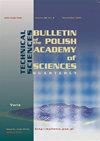DNP-NMR光谱回旋管的研究进展
IF 1.1
4区 工程技术
Q3 ENGINEERING, MULTIDISCIPLINARY
Bulletin of the Polish Academy of Sciences-Technical Sciences
Pub Date : 2023-11-06
DOI:10.24425/bpasts.2022.140354
引用次数: 2
摘要
本文章由计算机程序翻译,如有差异,请以英文原文为准。
The gyrotron for DNP-NMR spectroscopy: A review
. This paper outlines the principle of the DNP-NMR technique. The gyrotron, as a very promising microwave source for NMR spectroscopy, is evaluated. Four factors: power stability, power tuning, frequency stability, and frequency tuning determine the usability of the gyrotron device. The causes of instabilities, as well as the methods of overcoming limitations and extending usability are explained with reference to the theory, the numerical and experimental results reported by gyrotron groups.
求助全文
通过发布文献求助,成功后即可免费获取论文全文。
去求助
来源期刊
CiteScore
2.80
自引率
16.70%
发文量
0
审稿时长
6-12 weeks
期刊介绍:
The Bulletin of the Polish Academy of Sciences: Technical Sciences is published bimonthly by the Division IV Engineering Sciences of the Polish Academy of Sciences, since the beginning of the existence of the PAS in 1952. The journal is peer‐reviewed and is published both in printed and electronic form. It is established for the publication of original high quality papers from multidisciplinary Engineering sciences with the following topics preferred:
Artificial and Computational Intelligence,
Biomedical Engineering and Biotechnology,
Civil Engineering,
Control, Informatics and Robotics,
Electronics, Telecommunication and Optoelectronics,
Mechanical and Aeronautical Engineering, Thermodynamics,
Material Science and Nanotechnology,
Power Systems and Power Electronics.

 求助内容:
求助内容: 应助结果提醒方式:
应助结果提醒方式:


